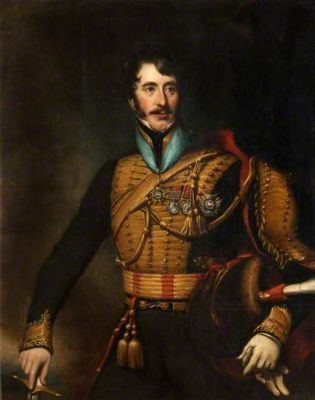Name Sir Verner, | ||
 | ||
Died 1871, Eaton Square, London, United Kingdom | ||
Sir William Verner, 1st Baronet, KCH (25 October 1782 – 20 January 1871), was a British soldier who served in the Napoleonic wars, was wounded at the Battle of Waterloo and resigned as a Colonel. He served as a politician, including 36 years as a member of Parliament. Two of his sons were also members of Parliament. Verner was made Knight Commander of the Hanoverian Order and a Baronet, and was Grand Master of Armagh and Orange Order of Ireland.
Contents
- Early life
- Military
- Public service
- Marriage and family
- Churchill
- Inismagh
- Eaton Square
- Death
- Honours and titles
- References

Early life
William Verner was the son of Colonel James Verner, a member of Parliament, and Jane Clarke. As a boy, he studied at Woodville, which overlooked Lucan, Dublin. He had the opportunity to attend the Trinity College, Dublin, but preferred a career in the army.
Military
Verner's interest in an army career began when he commanded the Churchill Yeomanry. At first he was a staff officer under the Lord Lieutenant of Dublin in the 7th Queen's Own Hussars. He fought in the Peninsular War of the Napoleonic Wars at the Battle of Corunna under Sir John Moore in 1808-1809. He also fought at the Battle of the Pyrenees under the Duke of Wellington, in 1814 at the Battle of Orthes and the Battle of Toulouse, and in 1815 the Battle of Waterloo, rising to the rank of Lieutenant-Colonel in the 7th Queen's Own Hussars, under Lord Henry Paget, 1st Marquess of Anglesey. Verner was wounded by a musket shot to the head at Waterloo and retired from the Army with the rank of Colonel.
Public service
William held three positions as High Sheriff: first for County Monaghan in 1820, County Armagh 1821 and last for County Tyrone 1823. He was also a Justice of the Peace and Deputy Lieutenant of Tyrone. He was a member of the Conservative party and a Member of Parliament for County Armagh between 1832 and 1868.
A supporter of the Protestant Orange Order, he was once struck off the Commission of the Peace by Lord Normanby for toasting the Battle of the Diamond at a public dinner in Ireland.
Marriage and family
He married Harriet Wingfield, daughter of Colonel the Hon. Edward Wingfield, younger son of Richard Wingfield, 3rd Viscount Powerscourt, and Harriet Esther Westenra, on 19 October 1819. The couple had 2 sons and 8 daughters, at least 2 of which died in infancy. The children were buried at Powerscourt.
He seemed to have good relationships with his children, who called their father "Taffy", they included William, Edward Wingfield, Amelia, Frederica, Cecelia, Frances Elizabeth, Harriet Jane Isabella, and Constantina Henrietta Frances. William, his first son, helped him with his political work and became a member of Parliament for the County Armagh. His second son, Edward Wingfield Verner, was from 1863 an MP for Lisburn and after his older brother's death, became MP for County Armagh, a position he held until 1880 when he resigned.
Churchill
Following the Battle of Waterloo, and seeing his father in failing health, he took over the running of the family estate, named Churchill, which included the house, a church with a bell inscribed to the Virgin Mary, and graveyard. In 1788, he received the estates following the death of Thomas Verner, Esquire, his paternal great uncle. In addition to Churchill in Armagh, Thomas Verner also had estaes in Meath, Monaghan and Tyrone. Since William was only 5 years-old in 1788, his parents James and Jane moved into the home with their family and were guardians of the residence until 1807.
During the potato famine (1845-1852), Verner offered work to any of his tenants in need and reduced rents by as much as half.
Inismagh
Verner also had property at Annahoe in County Tyrone, Ireland.
Eaton Square
Verner met his wife in London and after they were married they bought a home there at 86 Eaton Square. Harriet also visited her parents often at Corke Abbey.
Death
Verner had good health until 1870 when he began to decline. He died on 20 January 1871 at his home at Eaton Square. His body was sent to Loughgall, County Armagh in Northern Ireland for his funeral and burial. The procession was 2 miles long and was estimated to have included 10,000 people.
Honours and titles
In 1837, he was also made Knight Commander of the Hanoverian Order by Sir Robert Peel or William IV. On 22 July 1846, Verner was created a baronet, of Verner's Bridge in the County of County Armagh. He was a Grand Master for Armagh and a Deputy Grand Master of the Orange Order for Ireland.
